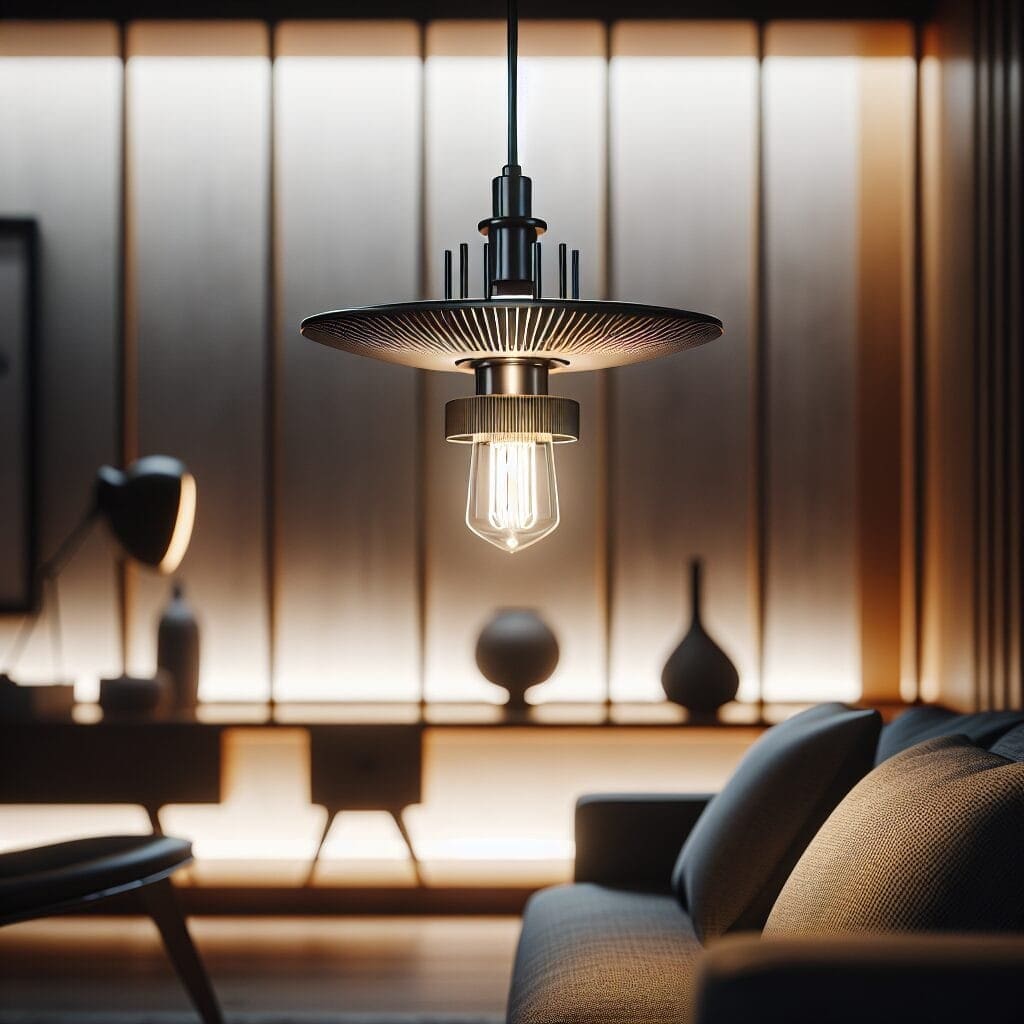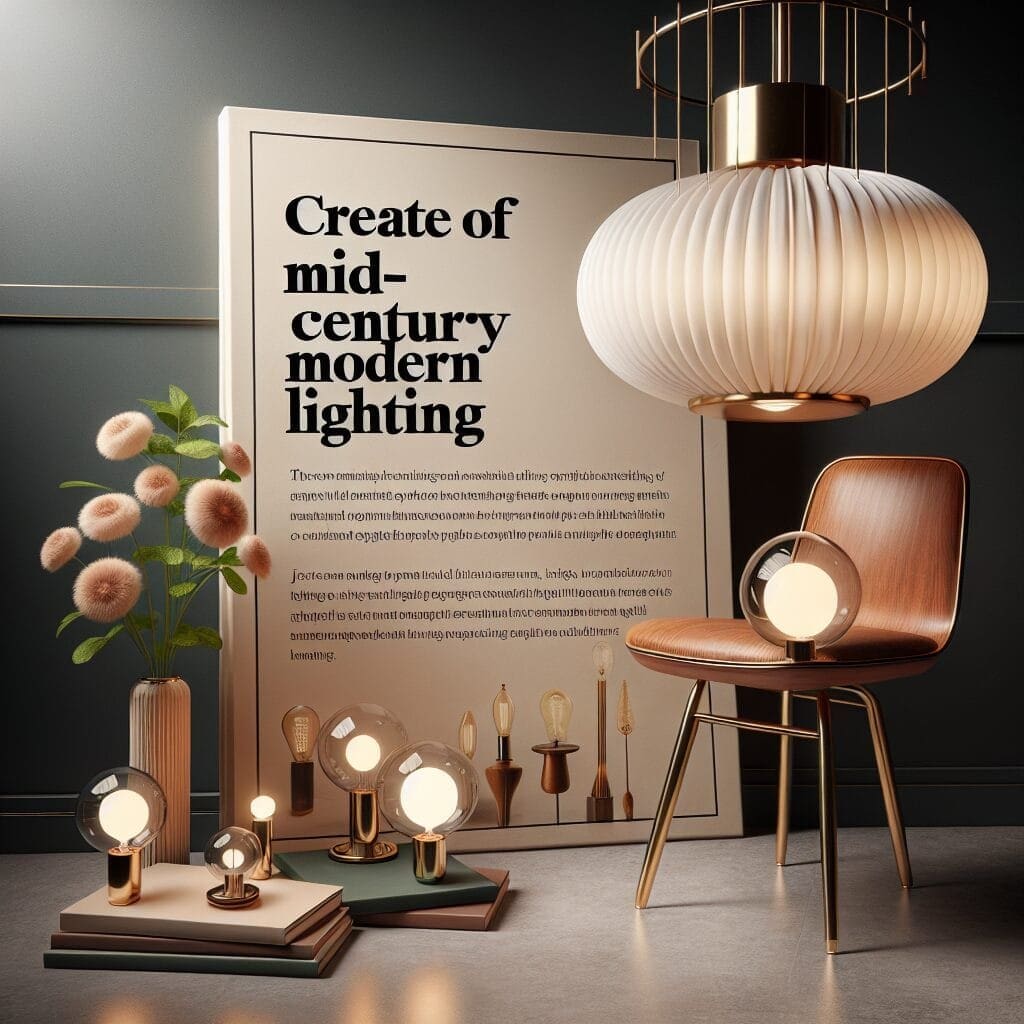If you're a fan of the timeless and chic Mid-Century Modern style, you probably appreciate the sleek lines and artistic flair of its lighting fixtures. Incorporating these iconic pieces into a modern home can add a touch of vintage allure and elegance. To help you achieve the perfect balance between old and new, we've compiled three tips for styling Mid-Century Modern lighting in a modern home. By following these suggestions, you'll be able to create a harmonious and captivating aesthetic that seamlessly combines the best of both worlds.

Choose the Right Fixtures
When styling mid-century modern lighting in a modern home, it's crucial to choose the right fixtures that not only match the overall aesthetic of the space but also provide the appropriate scale and size. Consider the dimensions of the room and the height of the ceiling when selecting fixtures. A large, grand chandelier might look stunning in a spacious living room with high ceilings, but it could overwhelm a smaller space. On the other hand, a petite pendant light might get lost in a large, open-concept room. Take the time to measure the room and consider the proportions before settling on the perfect fixture for your space.
Additionally, it's important to select the appropriate style of mid-century modern lighting. There are various styles within this genre, ranging from sleek and minimalistic to bold and vibrant. Consider the design aesthetic of your modern home and choose fixtures that complement it. For a more contemporary look, opt for fixtures with clean lines and minimalist appeal. If your home leans towards a bohemian vibe, select fixtures with unique shapes and pops of color. By selecting fixtures that align with your home's overall style, you'll create a cohesive and visually pleasing atmosphere.
Finally, pay attention to the placement of your mid-century modern fixtures. Lighting placement can greatly impact the overall ambiance of a room. Consider the function of the space and strategically place fixtures accordingly. For example, in a dining room, hang a chandelier directly above the table to create a focal point and provide ample lighting for meals. In a reading nook, place a floor lamp or wall sconce near a comfortable chair for optimal task lighting. By carefully considering the placement of your fixtures, you'll not only enhance the functionality of the space but also create a visually appealing composition.
Combine with Contemporary Elements
To create a stylish and balanced mix in a modern home, it's essential to combine mid-century modern lighting with contemporary elements. This juxtaposition adds depth and interest to the space, creating a dynamic visual experience.
When combining mid-century modern lighting with contemporary elements, strive for a balanced mix. This means incorporating an equal blend of mid-century and contemporary pieces to maintain harmony in the space. For example, if you have a mid-century modern pendant light in the dining area, balance it out with contemporary dining chairs and a sleek, modern dining table. This combination creates a cohesive look while still honoring the mid-century modern aesthetic.
Another way to achieve a balanced mix is by using contrasting materials. Mid-century modern lighting often features materials such as brass, glass, and wood. Pair these fixtures with contemporary elements that incorporate materials like chrome or stainless steel to create an interesting contrast. The interplay of different textures and finishes adds depth and complexity to the overall design.
Additionally, incorporating mid-century colors into your contemporary space can enhance the overall aesthetic. Mid-century modern design often embraces bold, vibrant colors such as teal, mustard yellow, and burnt orange. Introduce these colors through accessories like throw pillows, rugs, or artwork to add a touch of retro charm while still maintaining a modern look.
Focus on Ambient Lighting
Ambient lighting sets the overall mood and provides general illumination in a room. When styling mid-century modern lighting in a modern home, it's important to pay attention to ambient lighting to create a warm and inviting atmosphere.
To create a cozy ambiance, consider installing dimmer switches for your mid-century modern fixtures. Dimming the lights allows you to adjust the brightness according to the desired mood or activity in the room. Whether you're hosting a dinner party or enjoying a quiet evening at home, having the ability to dim the lights provides flexibility in setting the perfect ambiance.
In addition to overhead fixtures, use floor and table lamps to add ambient lighting to the space. Place floor lamps strategically in corners or behind furniture to cast a warm glow and create a cozy atmosphere. Table lamps can be placed on side tables or nightstands to provide soft, ambient lighting for specific areas of the room. By incorporating a variety of lighting sources, you'll create a multi-dimensional and inviting space.
Pendant lights are also an excellent option for adding ambient lighting to a room. Hang pendant lights in clusters or rows to create a statement piece and distribute light evenly across the space. Pendant lights can be used in entryways, hallways, or above kitchen islands to provide both style and functionality.

Consider Proportions and Placement
When incorporating mid-century modern lighting into a modern home, it's important to consider proportions and placement to ensure a visually pleasing and balanced composition.
Opting for symmetry with your lighting choices can create an aesthetically pleasing and balanced look in the room. Symmetrical placement of fixtures helps create a sense of order and harmony. For example, hanging matching sconces on either side of a fireplace or placing identical table lamps on either side of a sofa can create a visually pleasing symmetry.
When hanging chandeliers, it's important to consider the right height. The bottom of the chandelier should hang at a height that allows the fixture to be the focal point of the room without obstructing views or overwhelming the space. As a general rule of thumb, the bottom of the chandelier should be around 30-36 inches above the dining table or at a height that doesn't interfere with the line of sight.
To achieve uniform lighting across the room, spread the lighting sources strategically. Instead of relying solely on a single overhead fixture, incorporate multiple sources of light to ensure even illumination. This can be achieved by combining overhead fixtures with floor lamps, table lamps, and wall sconces. Distributing lighting throughout the room helps eliminate harsh shadows and creates a more balanced and visually appealing environment.
Highlight Architectural Features
Mid-century modern lighting can be used strategically to highlight and enhance the architectural features of a modern home. By directing light towards various elements, you can create a focal point and add depth to the space.
One way to utilize mid-century lighting to highlight architectural features is by directing light towards artwork. Install picture lights or track lighting above paintings or sculptures to draw attention to these pieces and create a gallery-like atmosphere. By illuminating artwork, you can accentuate its beauty and add dimension to the room.
If your modern home has built-in shelving, incorporating lighting within these shelves can create a stunning visual effect. Install under-cabinet lights or LED strips along the edges of the shelves to illuminate your book collection or display items. This creates a warm and inviting atmosphere while also providing practical task lighting for the shelves.
Exposed beams are another architectural feature that can benefit from mid-century modern lighting. By placing track lighting or adjustable spotlights along the beams, you can highlight their unique texture and add a sense of drama to the space. This lighting technique not only showcases the architectural beauty of the beams but also adds a warm and inviting ambiance to the room.
Don't Overlook Task Lighting
While ambient lighting sets the overall mood in a room, task lighting is essential for specific activities that require focused illumination. When styling mid-century modern lighting in a modern home, it's important not to overlook the importance of task lighting.
Ensure that workspaces in your home, such as desks or kitchen countertops, have adequate task lighting. Select fixtures that provide targeted illumination to prevent eye strain and optimize productivity. Adjustable desk lamps or under-cabinet lights in the kitchen are great options for task lighting. These fixtures allow you to direct the light exactly where you need it most.
Opt for adjustable fixtures when possible to cater to different task lighting needs. Adjustable floor lamps or wall sconces with swivel arms can be positioned to provide optimal lighting for reading or working on crafts. The ability to adjust the angle and direction of the light allows for flexibility and personalized lighting solutions.
In spaces dedicated to reading, such as a cozy nook or a bedroom, consider installing reading lights. These can be wall-mounted or attached to the headboard, providing targeted illumination for reading without disturbing the overall ambient lighting in the room. Reading lights bring both functionality and style to the space, allowing you to comfortably indulge in your favorite books.
Utilize Layered Lighting
Layered lighting is an effective technique that combines task, ambient, and accent lighting to create a visually interesting and versatile space. When styling mid-century modern lighting in a modern home, incorporating a variety of lighting layers can add depth, dimension, and flexibility to the overall design.
Mixing task, ambient, and accent lighting creates a multi-dimensional atmosphere that caters to different needs and moods. Task lighting provides focused illumination for specific activities, while ambient lighting sets the overall mood, and accent lighting highlights specific features or creates visual interest.
To create visual interest through layered lighting, experiment with different fixtures and their placement. Combine a pendant light over a dining table with wall sconces to create a dynamic ambiance during meals. Use floor lamps in conjunction with overhead fixtures to provide a combination of focused and ambient lighting in a living room. By mixing and matching different lighting sources, you can create a unique and visually engaging environment.
Adjustability is another key aspect of layered lighting. By incorporating dimmer switches, you can adjust the brightness of each layer according to the desired mood or time of day. This allows for flexibility in creating different atmospheres and adapting to various activities or occasions.
Incorporate Organic Elements
When styling mid-century modern lighting in a modern home, incorporating organic elements can add warmth and a connection to nature, balancing the clean lines and sleekness of the overall design.
Add natural materials to your lighting choices. Mid-century modern lighting often features materials such as wood and rattan. Opt for fixtures made from these materials to infuse a sense of nature into your space. Pendant lights with wooden or woven shades can bring a touch of organic beauty to any room. The natural textures add depth and warmth while harmonizing with the overall mid-century modern aesthetic.
Integrating plant life into your space is another way to incorporate organic elements. Place potted plants near your mid-century modern lighting fixtures to create a sense of freshness and vitality. The combination of living greenery and warm lighting creates a soothing and natural ambiance.
Choosing earthy tones for your lighting fixtures adds a sense of warmth and connection to nature. Opt for fixtures in colors like warm browns, muted greens, or soft earthy tones. These color choices complement the mid-century modern aesthetic while providing a calming and grounding effect.
Balance Lighting and Furniture
When styling mid-century modern lighting in a modern home, it's important to consider the balance between lighting and furniture to create a cohesive and visually pleasing arrangement.
Consider the proportions of both the lighting fixtures and the furniture in the room. Ensure that the size and scale of the lighting fixtures are in harmony with the size of the furniture pieces. For example, a large, statement pendant light might overpower a small dining table, while a small bedside lamp might get lost on a large nightstand. By considering the proportions, you can ensure that the lighting and furniture work together to create a balanced and visually appealing composition.
Allow the lighting fixtures to complement the furniture in terms of style. If you have sleek, modern furniture, consider choosing mid-century modern lighting fixtures with clean lines and minimalistic design. On the other hand, if your furniture features bold colors or unique shapes, select lighting fixtures that complement and enhance these features. By allowing the lighting fixtures to complement the furniture, you create a cohesive and harmonious arrangement that ties the room together.
Avoid cluttered arrangements by strategically placing lighting fixtures throughout the room. Each lighting source should serve a purpose and contribute to the overall design. Distribute lighting evenly and consider the sightlines and flow of the room. Avoid placing fixtures where they might obstruct views or create visual clutter. By creating a well-balanced and thoughtfully curated lighting arrangement, you'll create a visually pleasing and harmonious space.
Experiment with Bulb Types
The type of bulbs you choose for your mid-century modern lighting fixtures can greatly impact the overall ambiance of your modern home. By experimenting with different bulb types, you can achieve different moods and aesthetics.
Consider choosing warm and soft white light bulbs for a cozy and inviting ambiance. Warm white bulbs emit a soft, yellowish glow that mimics the warmth of natural sunlight. This type of lighting creates a comfortable and welcoming atmosphere, perfect for relaxing and unwinding after a long day. Soft white bulbs offer a slightly cooler tone while still providing a cozy and soothing ambiance.
For a touch of vintage charm, try Edison or filament bulbs. These bulbs have exposed filaments that create a warm and nostalgic glow reminiscent of early lighting designs. Edison bulbs can add a retro and industrial aesthetic to your mid-century modern fixtures, creating a unique focal point in the room. Experiment with different shapes and sizes of filament bulbs to find the perfect fit for your space.
Consider energy-efficient options when selecting bulbs for your mid-century modern fixtures. LED bulbs are an excellent choice as they consume less energy and have a longer lifespan compared to traditional incandescent bulbs. LED bulbs come in various color temperatures, allowing you to customize the ambiance of your space while also reducing your energy consumption.
By experimenting with different bulb types, you can create the desired mood, aesthetic, and functionality in your modern home while staying true to the mid-century modern lighting style.
In conclusion, styling mid-century modern lighting in a modern home requires careful consideration of various factors such as fixture selection, scale and size, style, placement, and bulb types. By following these tips and guidelines, you can create a visually pleasing, cohesive, and inviting space that combines the best of mid-century modern design with contemporary elements. Remember to focus on creating a balanced mix, paying attention to different lighting layers, highlighting architectural features, incorporating organic elements, and ensuring harmony between lighting and furniture. With these considerations in mind, you'll be well on your way to achieving a stunning and stylish mid-century modern lighting design in your modern home.










